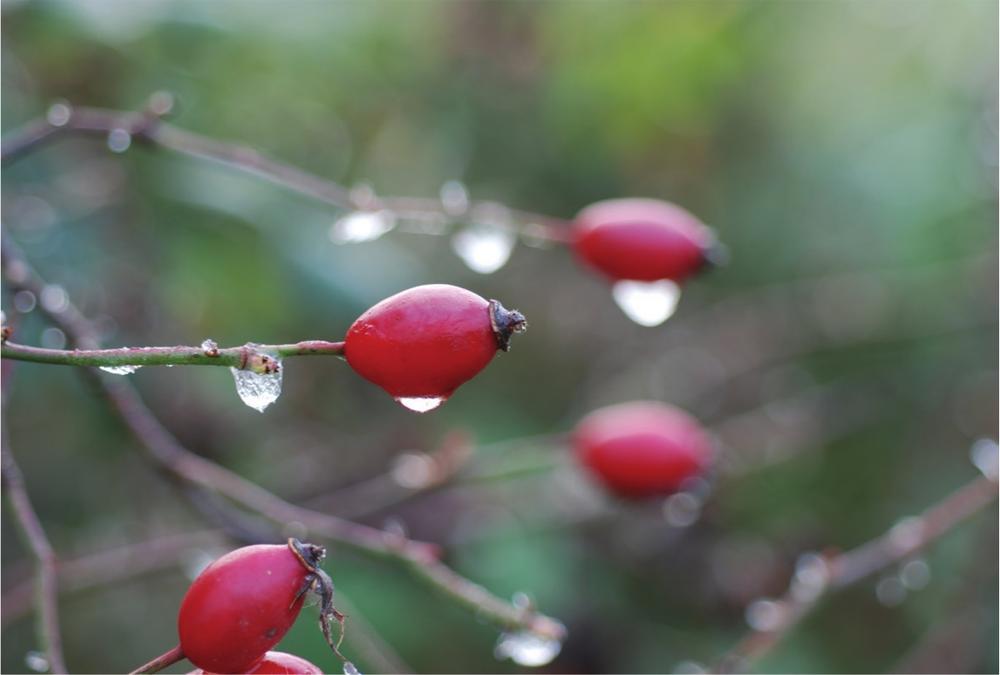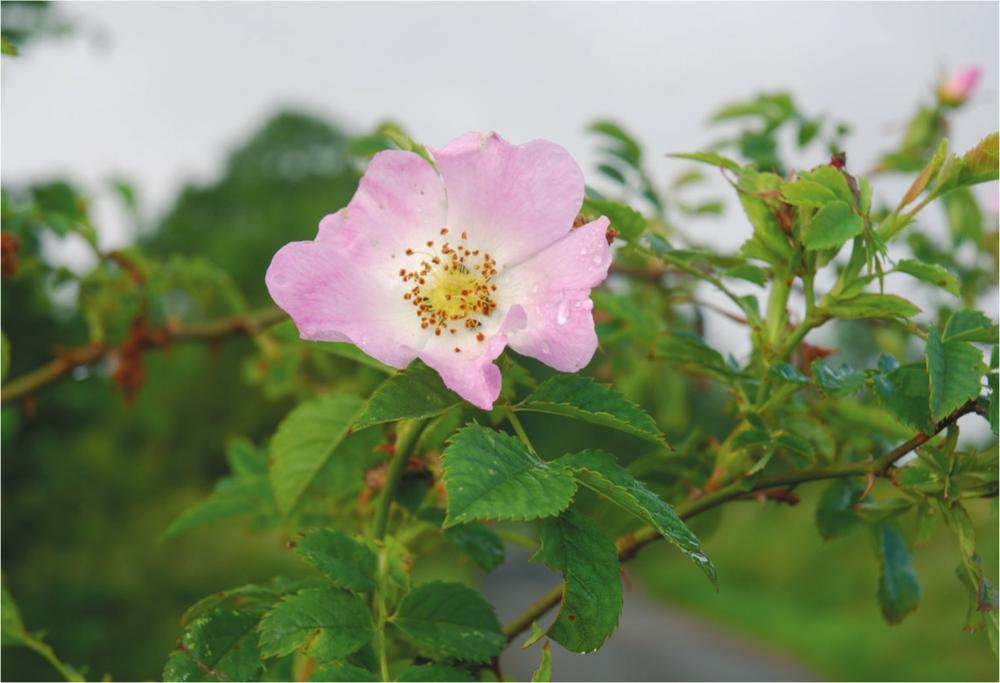For centuries the wild or dog rose was valued most for its galls, used to eliminate the stone. It was only in the 1930s that the value of the hips was proven, just in time for their use in a vitamin-rich syrup given to Britain’s wartime children against infection.
Rose is the plant of love, the petals being the basis of the perfume industry. Herbally, it supports the immune system, is a good eliminator and is cooling to the body.

Rosaceae Rose family
Description: Rambling deciduous shrubs with thorny stems and pink or white flowers, followed by bright scarlet hips in the autumn.
Habitat: Hedgerows, scrub and woods.
Distribution: Widespread.
Species used: There are several species, and they can all be used medicinally. Dog rose (R. canina) is the most common, with fragrant pale pink or white flowers and scarlet hips. Sweetbriar (Eglantine) roses (R. rubiginosa) have pretty apple-scented leaves and stems.
Parts used: Flowers gathered in midsummer and hips harvested in autumn.
Autumn brings mist and mellow fruitfulness, in Keats’s famous words, but he overlooks the frosts and ’flus of the new season. Fortunately, our hedgerows are ‘loaded and blessed’ with a bounty of rose hips to help us build up strength and resistance for the winter.
Everybody now knows that rose hips contain plentiful vitamins and minerals, but it was only in the 1930s that research established that home-grown hips had twenty, even forty times more vitamin C than imported oranges, plus good supplies of vitamins A, B and K.
Oranges were to be an early casualty of the Second World War in Britain, and the Ministry of Food turned to the nation’s school children to collect the domestic alternative. By 1945 amounts of 450 tons or so of rose hips were gathered each autumn to make into syrup; collectors were paid 3d a pound, a useful bit of pin money for youthful entrepreneurs.
Rose hip syrup was rationed and provided to mothers for their children through the war years and for some time thereafter. The syrup (made by Delrosa) was in the shops, although Matthew, a post-war baby, remembers better the joy of seeing and eating his first orange in the early 1950s.
Use wild rose for…
Rose hips and petals (the leaves are not used much) offer support to the body’s immune system and help fight infection in the digestive tract; they are also diuretic, ie assist in elimination of wastes through the urinary system, as well as cooling to the body, bringing down fevers and reducing heat on the skin in the form of rashes and inflammations.
This threefold action – supporting immunity, helping elimination, and being cooling – makes rose a superb natural reliever of cold and ’flu symptoms, sore throats, runny noses and blocked chests.

The effect is not only good for children, and rose hip tea as well as syrup are often given to convalescents and older people to improve their general resistance, as well as lighten their mood.
But there is one note of caution in this roll-call of autumnal virtue. The official wartime instructions emphasised that while the flesh of dog rose hips was so good for you the seeds, with their short hairs, were possibly dangerous if taken internally. However, the same hairs have provided ‘itching powder’ fun for generations of boys.
Straining stewed hips to remove the irritant hairs was specified in the wartime recipe, and is still noted in instructions for the syrup.
Rose petals were favoured by herbalists of old mainly for cooling and astringent qualities, and to strengthen the heart and spirits. Today’s herbalists use them in hormone-balancing formulae and for support in life-cycle stages. Rose hips, petals and essential oil all buttress the nervous system, relieving insomnia, soothing the nerves and lifting depression, as well as evening out heart palpitations and arrhythmias.
The astringent effect, particularly of the petals, is a result of high tannin levels, which help make rose useful in staunching bleeding and unwanted discharges. There is an effect too on the digestive system, cutting over-acidity and over-activity in the stomach, as well as reducing the spasms involved in diarrhoea, colitis and dysentery.
The petals have good antiviral properties and combine well with St John’s wort, elder and self-heal for treating viral infections. There are recent claims for anti-HIV qualities in R. damascena, the damask rose.
Additionally, the petals, whether in the form of a water infusion, a distilled rose water or, as in our recipe, a glycerite, make a fragrant skin toner and cleanser, which will take the heat out of boils, acne, spots and rashes. Rose water is also a soft, safe eyewash, mouthwash and gargle, and a douche.
A story is told in The Odyssey of how good rose is for the skin, as well as winning the heart. Milto, a young girl and the daughter of a humble artisan, would put a fresh garland of roses each morning in the temple of Venus, the goddess of love. Milto was beautiful, but at one time a boil began to grow on her chin, and she became distraught.
In a dream the goddess came to Milto and told her to apply some of the roses to her face. She did so, and recovered her beauty and equanimity to such an extent that she later became the favourite wife of the Persian emperor Cyrus.
Rose petals make a wonderful cooling tonic for the whole female reproductive system, reducing uterine pain and the cramp of heavy periods, and supplementing other treatment of infertility and low libido. Rose’s cooling and balancing qualities are particularly helpful during the menopause.
This is the ultimate feminine flower, found in practically every perfume, soap and aphrodisiac, yet men often need it too, and rose can be used to treat impotence.
Rose has a softening action on the heart on an emotional level, and it is no accident that a dozen red roses are a conventional expression of the lover’s feelings. Rose is prescribed by herbalists if the emotional aspect of ‘heart’ is affected or there is a need for love. Rose helps us to love ourselves and be open to the love of others.
So, given all this, does the wild rose of Britain deserve its name ‘dog’? This might derive from derogatory comments on its commonness – Pliny the Elder (AD 23–79), for example, thought Britain was named Albion because it was covered with white roses (alba meant white).
But rose’s defenders prefer an origin from an Anglo-Saxon term meaning ‘dagger’, for the thorn, or possibly the branch out of which dagger handles could be made. Another version of the name is that rose root was once thought to cure rabies, hence dog rose.

What may be less known today is that for centuries the main use of wild rose was for its gall or ‘briar balls’, known as Robin’s pincushions or bedeguars. Apothecaries ground them into a powder and sold them to treat kidney or bladder stone and as a diuretic. This use is long obsolete.

In any event, the success of the modern domesticated rose owes much to the wild form, and it is still usual for more tender species of ornamental roses to be grafted on to a wild rootstock. The petals of your garden roses can be used medicinally, if they are fragrant.
The Seals have a family story of rose grafting. Matthew’s grandfather Ted Seal lived in Leicester and was a fervent gardener. For a private joke he grafted some big blowsy roses on to wild briars growing by the railway line to London.
He said he wanted to confuse the passengers and make them think the country roses near Leicester were something special. Perhaps he was one of those people who knew that thorns have roses.
Rose petal glycerite
You can use garden roses along with wild roses for this recipe, as long as they haven’t been sprayed.
Pick fragrant rose petals and put them in a jar with a mixture of 60% vegetable glycerine and 40% water. Put the jar on a sunny window ledge or in a warm place. Stir occasionally to keep the petals beneath the surface of the liquid. You can add more petals over the season, removing any that have turned transparent. When the last petals have lost their colour, strain off the liquid and bottle. It should have a powerful aroma of rose, and taste heavenly.
Uses: 1 teaspoonful as needed for sore throats or viral infections.
For a ‘broken heart’ or grief, mix half and half with hawthorn tincture and take 1 teaspoonful several times a day. Rose glycerite is a pleasant addition to many herbal tinctures and formulae.
As a face lotion for dry or delicate skin, mix half and half with water and apply daily.
Rose hip vinegar
Put 20 or 30 rose hips in a jar or flask and cover with apple cider vinegar. If you want to speed up the process, slit the skins of the hips with a sharp knife before putting them in the vinegar. Leave on a sunny window sill for about a month, then strain and bottle.
Uses: For sore throats, mix a tablespoonful with a little warm water, gargle and then swallow. For colds, make a drink using a tablespoon of rose hip vinegar in a mug of hot water, sweetened to taste with honey; or use in salad dressings.

Raw rose hip syrup
Gently score a few lines through the skin of red rose hips, then layer them in a wide-mouthed jar with enough sugar to fill up all the gaps between the hips. Leave on a sunny window sill for a couple of months or until the sugar has drawn the juice from the hips and liquified. Strain off the liquid, bottle and store in the fridge. This is a really thick and delicious syrup. Take a teaspoonful or two daily to prevent colds.
Boiled rose hip syrup
This is the more traditional way to make the syrup, and what it may lose in vitamin C content it gains in having a longer shelf life.
Measure the volume of the rose hips you have picked, then pour them into a saucepan with half their volume of water (500ml water to 1 litre hips). Boil hips and water for 20 minutes in a covered saucepan. Allow to cool, then strain through a jelly bag. For every 2 cups of juice, add 1 cup sugar. Boil for 10 minutes and pour while still hot into sterilised bottles. Label bottles when cool. Take a teaspoonful or two daily to prevent colds, or more frequently as needed for sore throats and colds.
